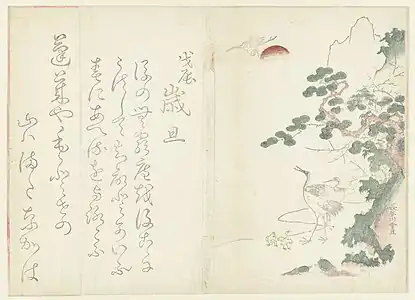Hasegawa Settan
Hasegawa Settan (長谷川雪旦,[1] 1778–1843)[2] was a Japanese artist who lived during the late Edo period, born in Edo.
His given name was Munehide (宗秀), and his art-name was Gengakusai Ichiyōsai (巌岳斎 一陽庵). He was commonly called Gotō Uzaemon (後藤右衛門). He was originally a wood sculptor and he carved the woodblocks for many ukiyo-e prints. The Edo meisho zue, an illustrated catalogue of the sights of Edo for which he provided in the woodcuts, is one of his major works.[2][3][4] For his artistic accomplishments, Hasegawa Settan was awarded the honorary Buddhist title Hokkyō (法橋 "Bridge of the Dharma").
 Drawing of a seal that washed up on a beach near Karatsu
Drawing of a seal that washed up on a beach near Karatsu



References
- Goree 2017, p. 411.
- Graham, Patricia Jane (2007). Faith and Power in Japanese Buddhist Art, 1600–2005. University of Hawaii Press. p. 42. ISBN 978-0-8248-3191-2.
- Douglas 1897, p. 13.
- Shirane, Haruo (5 March 2013). Japan and the Culture of the Four Seasons: Nature, Literature, and the Arts. Columbia University Press. p. 171. ISBN 978-0-231-15281-5.
Sources
- Douglas, R. K. (1897). "Japanese Illustrated Books". In Pollard, Alfred William (ed.). Bibliographica. Kegan Paul, Trench, Trübner. pp. 1–29.
 This article incorporates text from this source, which is in the public domain.
This article incorporates text from this source, which is in the public domain. - Goree, Robert (2017). "Meisho zue and the Mapping of Prosperity in Late Tokugawa Japan" (PDF). Cross-Currents: East Asian History and Culture Review. 6 (2): 404–439. doi:10.1353/ach.2017.0023. ISSN 2158-9674.
This article is issued from Wikipedia. The text is licensed under Creative Commons - Attribution - Sharealike. Additional terms may apply for the media files.
